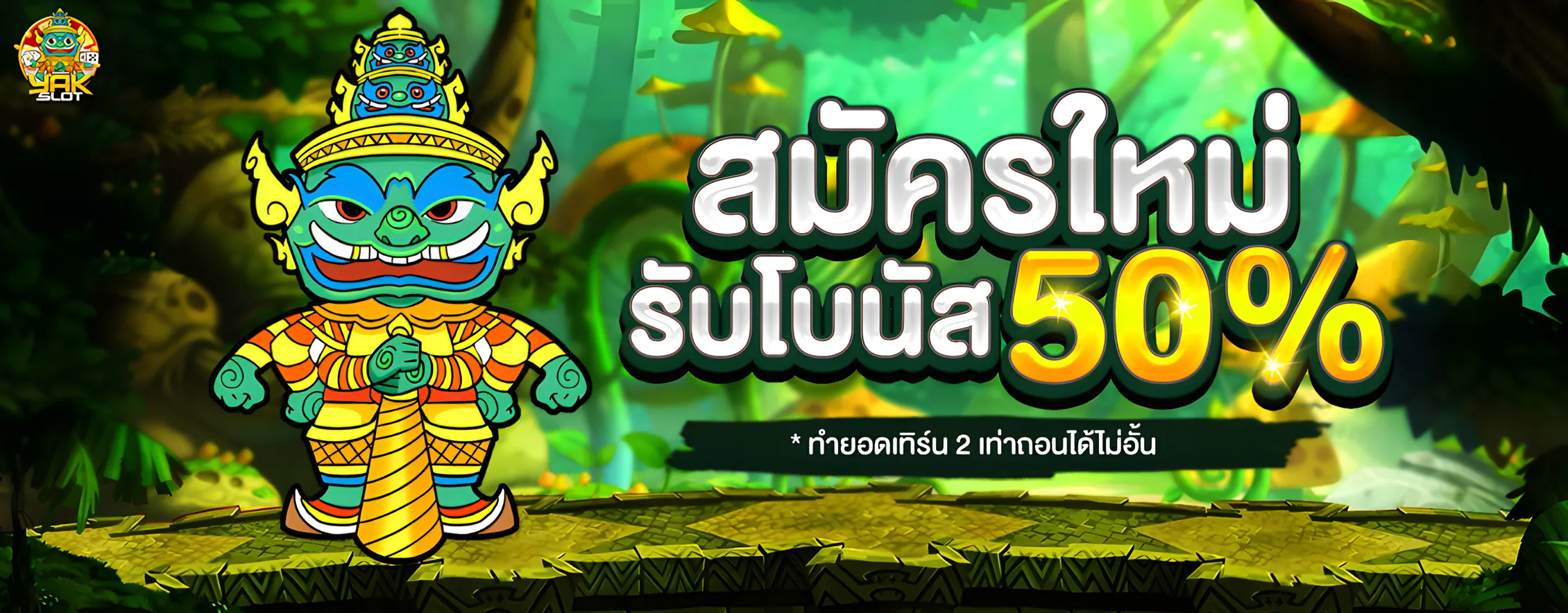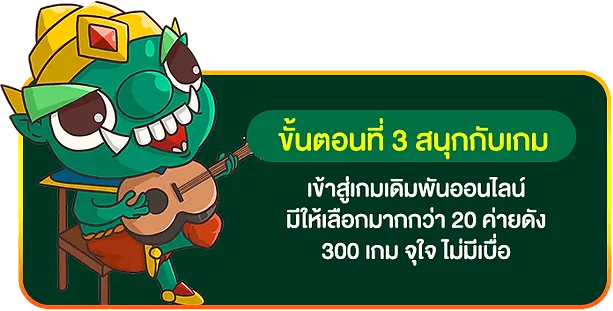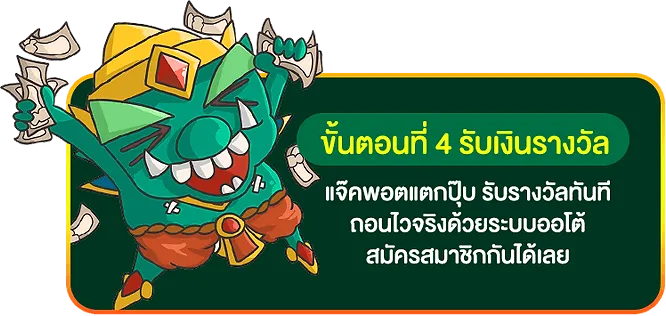





สล็อตยักษ์เขียว เว็บไซต์ทำเงินที่ดีที่สุด เว็บไซต์สร้างรายได้ ผู้ให้บริการเกมสล็อตที่ดีที่สุด รวบรวมเกมสล็อตจากค่ายชั้นนำทั่วโลกมาไว้ในที่เดียว เลือกเล่น และเดิมพันได้ตามใจคุณ สล็อตไทย สล็อตต่างประเทศ สล็อตเว็บไซต์ต่างประเทศ ไม่ว่าเกมสล็อตประเภทไหนก็ตาม ที่นี่เรามีให้สำหรับทุกคน เลือกเดิมพันได้ทุกประเภท ไม่ต้องค้นหาเกมสล็อตให้ถูก ไม่เสียเวลาอีกต่อไป ติดต่อเว็บไซต์โดยตรง ไม่โกง
มีเจ้าหน้าที่คอยดูแลคุณ มีบริการทุกวันไม่ทิ้งให้อยู่เพียงลำพังในการแก้ปัญหาอย่างแน่นอน มาพร้อมโปรแกรมป้องกันการโกงที่ดีที่สุด ป้องกันการโกงและฉ้อโกงทุกประเภท 100% ฝากถอนรวดเร็ว ฝากถอนง่าย ฝากถอนในเวลาเพียง 10 นาที รวดเร็วถูกใจผู้เล่นทุกคนอย่างแน่นอน เว็บไซต์ Green Giant Slots ไม่ต้องรอให้ระบบทำธุรกรรมการฝากและถอนเงินให้เสร็จสิ้น ที่ใช้งานได้ยาวนานกว่า ครบจบในที่เดียว เกมฟรี หมุนฟรี แตกง่าย สล็อตหมุนฟรี ซื้อหมุนฟรี ทางลัดสู่แจ็กพอตก้อนโตที่ใครๆ ก็เข้าถึงได้ สล็อตยักษ์เขียว888


แตกง่าย ได้เงินจริง แหล่งรวมเกมสล็อต เกมได้เงินจริง ซึ่งใครๆก็สามารถเข้าถึงได้ ค่ายเกมล็อคชั้นนำทั้งหมด รวบรวมไว้ที่เดียว เลือกทำกำไรได้ทุกเกม เว็บไซต์ตรง เว็บไซต์แท้ เว็บไซต์ใหม่ ไม่โกง บริการครบวงจร ฝากถอนเร็ว ฝากถอนง่ายเพียงไม่กี่วินาที สะดวก รวดเร็ว รวยง่ายเพียงปลายนิ้วสัมผัส เว็บไซต์ Green Giant Slots สามารถเล่นได้บนมือถือทุกระบบ ไม่จำเป็นต้องดาวน์โหลดการเข้าถึงใด ๆ เพื่อเล่น
ทดลองใช้ฟรีสำหรับทุกคนเพื่อเรียนรู้ ศึกษารูปแบบเกมสล็อตของเรา ก่อนที่เราจะเริ่มทำกำไรด้วยเงินจริง ที่นี่ เรานำความมั่งคั่งมาแจก เพราะเขารวยจากเกมสล็อต จึงไม่แปลก อยากรวยเชิญครับ รับรองว่าคุณจะต้องชอบ เดิมพันถูก ไม่มีขั้นต่ำ แค่นำเงินไม่กี่ร้อยบาทมาเล่นก็มีเงินเป็นแสน เว็บไซต์ Green Giant Slots เริ่มเลยแล้วคุณจะรู้ว่าเกมสล็อตเล่นง่ายกว่าที่คุณคิด สล็อตยักษ์เขียว888
รวมเกมสล็อตจากทุกค่าย จ่ายจริง เกมสล็อตที่แตกง่าย แตกบ่อย เกมไหนดี ค่ายไหนมาแรง เรามีให้เลือกมากมายที่นี่ เลือกสร้างรายได้ได้ตามใจคุณ เกมสล็อตทุกเกมบนเว็บไซต์ของเราได้รับการคัดสรรมาอย่างดี เลือกเฉพาะเกมสล็อตแมชชีนที่ถอดรหัสง่าย ๆ ให้ทุกคนได้รับผลกำไรเต็มจำนวน เว็บไซต์สล็อตยักษ์สีเขียว โปรโมชั่นมากมาย ไม่มีทักษะหรือประสบการณ์ก่อนหน้านี้ที่สามารถเล่นกับแนวทางการทำเงินที่ดีที่สุดได้
คู่มือการทำกำไรที่เข้าถึงได้ของทุกคน รวบรวมวิธีการเพื่อชนะเกมสล็อตในที่เดียว เพียงแค่มีคู่มือการทำเงินของเรา คุณจะสามารถเข้าถึงเงินก้อนใหญ่ได้ ง่ายกว่า ทุนหนา กล้าจ่าย ส่งตรงจากต่างประเทศ อยากเล่นอะไรก็อยู่ตรงนั้น มันไม่เคยล้าสมัย เว็บไซต์สล็อต ยักษ์เขียว สมัครวันนี้และรับไปเลย โบนัสพิเศษมากมาย โปรโมชั่นดีๆ แบบนี้ เว็บเราจัดให้จริงๆ สล็อตยักษ์เขียว888
























ลองเล่นฟรีเพื่อเอาใจผู้เล่นทุกคน คนที่ยังไม่คุ้นเคยกับเกมสล็อตของเราได้เรียนรู้และศึกษารูปแบบเกมสล็อตของเรา ทุกคนสามารถใช้งานได้ก่อนเริ่มเดิมพันด้วยเงินจริง ผู้เล่นทั้งใหม่และปัจจุบันใส่ใจผู้เล่นแต่ละคนเพราะทุกคนอยู่ในครอบครัวของเรา เปลี่ยนชีวิตจากหลังมือเป็นข้างหน้าได้ง่ายๆเพียงข้ามคืน เว็บไซต์ Green Giant Slots จำกัดเครดิตเดียว ไม่ต้องเสียเวลาโอนเครดิตอีกต่อไป ฝากเงินเข้ากระเป๋าสตางค์ เล่นได้ทุกเกมแน่นอน ไม่สร้างปัญหาตอนนี้เครดิตไม่หมด
เว็บไซต์เกมสล็อตขนาดใหญ่ที่ใครๆ ก็เทียบได้ยาก โปรโมชั่นมากมายเข้าแจ็กพอต มันใช้งานได้จริงตามที่โฆษณาไว้ ไม่ปลอมแน่นอน เว็บไซต์ชั้นนำท้าให้คุณลอง วิธีหาเงินในยุค 2024 เว็บไซต์ Green Giant Slots มีให้เล่นทุกอย่างที่คุณต้องการ ไม่มีแนวโน้ม สมัครตอนนี้บนเว็บไซต์ สล็อตยักษ์เขียว 15 รับ 100

ร่วมสนุกไปกับสล็อตที่จะเปิดโอกาสให้คุณลุ้นรางวัลใหญ่! สล็อตเป็นเกมคาสิโนที่น่าสนใจและสนุกสนานที่สุดที่มีอยู่ในปัจจุบัน ด้วยกราฟิกที่สวยงามและเพลงที่น่าตื่นเต้น สล็อต ยักษ์เขียว 888 คุณจะมีประสบการณ์การเล่นเกมที่ไม่เหมือนใคร ไม่ว่าคุณจะเป็นมือใหม่หรือมือเก๋าก็สามารถร่วมสนุกได้ทันที
Green Giant Slots เป็นเกมที่มีโอกาสชนะรางวัลใหญ่สูง ด้วยรูปแบบการเล่นที่เข้าใจง่ายและรางวัลใหญ่มาก คุณจะมีสิทธิ์ลุ้นรับรางวัลมูลค่าสูงถึงล้านบาท ไม่ว่าคุณจะเป็นผู้เล่นที่มีประสบการณ์หรือไม่ก็สามารถร่วมสนุกได้ทันที เรามีระบบการเล่นที่เข้าใจง่ายและให้ลุ้นรางวัลมากมาย สล็อตยักษ์ไทย ด้วยสล็อต ยักษ์เขียว คุณจะได้สัมผัสประสบการณ์การเล่นเกมที่ไม่เหมือนใครและมีโอกาสชนะรางวัลแจ็คพอตก้อนโต สล็อตยักษ์เขียว 15 รับ 100

เว็บไซต์คาสิโนออนไลน์ ที่นำเสนอประสบการณ์การเล่นสล็อตที่ไม่เหมือนใครในโลกของเกมคาสิโน! ที่นี่คุณจะได้สัมผัสกับความสนุกสนานและโชคลาภอย่างที่ไม่เคยมีมาก่อน ด้วยเกมสล็อตที่หลากหลายและน่าตื่นเต้นมากมาย ไม่ว่าคุณจะชอบสไตล์การเล่นที่เรียบง่ายและไม่เป็นทางการ หรือบางทีคุณอาจต้องการความท้าทายและความตื่นเต้นในระดับที่สูงขึ้น มีทุกสิ่งที่คุณต้องการที่นี่
ไม่ว่าคุณจะเป็นมือใหม่ที่กำลังมองหาประสบการณ์คาสิโนออนไลน์ครั้งแรกหรือมืออาชีพที่เล่นมายาวนาน ที่นี่คุณจะได้พบกับเกมสล็อตคุณภาพสูงและการออกแบบที่สวยงาม รวมถึงรางวัลและโบนัสที่มีราคาสูงกว่าใครๆ ให้คุณมีสิทธิ์ลุ้นรับรางวัลใหญ่! ได้ทุกที่ทุกเวลาผ่านเว็บไซต์หรือแอพพลิเคชั่นที่รองรับระบบ iOS และ Android ซึ่งให้คุณเล่นเกมสล็อตที่คุณชื่นชอบได้ตลอดเวลา ไม่ว่าคุณจะอยู่ที่ไหนก็สามารถร่วมเล่นเกมสล็อตได้ที่นี่เสมอ นอกจากนี้ ยังมีทีมสนับสนุนลูกค้าคอยช่วยเหลือตลอด 24 ชั่วโมง สล็อตยักษ์เขียว


สล็อตยักษ์เขียว888 สล็อตยักษ์เขียว888 สล็อตฟรี ซื้อฟรีสปินในราคาถูก ทุกคนสามารถเข้าถึงเส้นทางสู่ความสำเร็จอันยิ่งใหญ่ได้
n83 com เข้าสู่ระบบ เว็บเดียวครบ รวมเกมทุกอย่าง เว็บที่ดีที่สุดที่ให้บริการเกม สล็อตออนไลน์ เกมยิงปลา เกมส์ออนไลน์ทุกประเภท ใหม่ล่าสุดด้วยระบบอัตโนมัติ
Copyright © 2024 ems6b.com | All Rights Reserved.